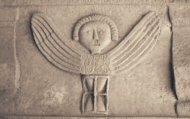|
The Moray Burial Ground Research Group |
 |
|||||
|
|
|
|
|
|
|
|
|
|
|
|
|
|
|
|
|
|
Request Free Quote for full MI Transcripts/Photos or Publications |
|
||||
The Buried Tombstones of MorayshireIn many of the old churchyards of Scotland there is a hidden archive. Although the Memorial Inscriptions on the visible stones are being recorded and published by many Family History Societies and local groups, the stones which are hidden beneath the surface are in most cases being ignored. This may be due to several factors. In order to locate all of these stones it is necessary to undertake a methodical survey of the whole of the burial ground. Even when the buried stones are located the deturfing, drawing, photographing, recording and returfing of these stones is a laborious and time-consuming task, and possibly outwith the scope of many of the present recording groups. The Moray Burial Ground Research Group was formed to undertake, over a period of years, a complete survey of every burial ground in Morayshire, under the following remit. “The purpose of the Research Group is to study all Burial Grounds and Memorials in Morayshire. This work is identified in several sectors, each of these bringing their own benefits and problems to the researchers. The research is being conducted in conjunction with The Council for Scottish Archaeology, as part of the Carved Stones Adviser Project (Dr Susan Buckham), and the Scottish Association of Family History Societies”. The work of the research group will be of benefit to Genealogists and Family Historians, to Local and Social Historians, to Archaeologists, to those involved in the Conservation of Burial Grounds, and to those in many other disciplines. The first phase of the work of the group is to create an Inventory of all Burial Sites, and of all locations of Monumental Inscriptions, in the area. This includes known Cemeteries and Burial Grounds, whether or not these are associated with a place of worship, and also Private Burial Grounds. Also included is research into the history and location of possible early Burial Sites which are now no longer in existence. Memorial Tablets within Churches are also included in this wide-ranging inventory, as although these may have initially only duplicated the information on the tombstones, many of these tombstones are now so worn or damaged, or have in fact disappeared, that the memorial within the church may be the only remaining record, and as such is worthy of inclusion. The second phase of the project is to complete a History of the Site, including Bibliographic and possible Archaeological information. This requires work in many archives, from Morayshire to Edinburgh, and in some cases even further afield. Phase three is to construct a Site Plan of each Burial Ground or Church on which to identify the location of all tombstones, memorial tablets, etc. Some plans are already in existence, but many need updating or revising. The fourth phase is divided into two sections, which may or may not be undertaken simultaneously. The first section, making use of the already prepared site plan, is to make a careful, complete and accurate record of all Monumental Inscriptions on the site. Although many of these have been done previously, some are in a very abbreviated form, and provide an incomplete record as to the style of text, etc. The second section is to locate and record all Buried Tombstones, using a very specific methodology, which is currently under examination prior to being authorised by The Council for Scottish Archaeology and Historic Scotland. These stones are de-turfed, recorded both by drawing and photography, and then re-turfed. The current, but possibly not final draft of the methodology is available from the Carved Stones Adviser Project of the Council for Scottish Archaeology. The final phase is to publish the results of this research, in two formats. The visible Monumental Inscriptions are published by the Aberdeen and North East of Scotland Family History Society, as part of their ongoing series. The Morayshire books in this series will also contain a brief history of the Burial Ground. The research into the Buried Stones will be published as a booklet to be of use to Family Historians, and also in an academic form, where required, to cover all aspects of research in a greater depth”. Bruce B Bishop, FSA Scot, Cert. SFHS Secretary, MBGRG Note: A schematic diagram is also available here |